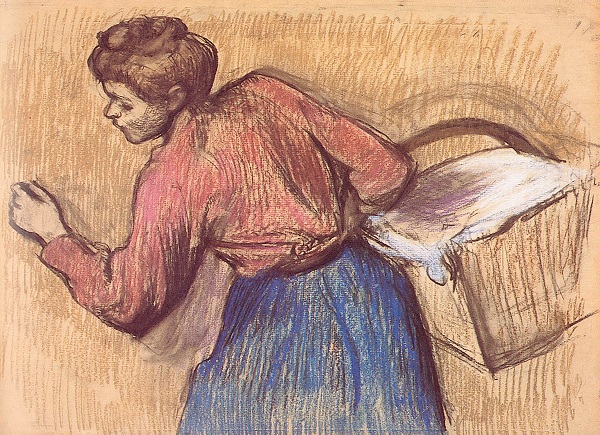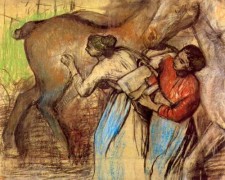
Edgar Degas
French, 1834-1917
Laundress Carrying Linen, 1888-1892
pastel
24 1/8 × 36 1/2 in.
Michael Armand Hammer and the Armand Hammer Foundation

Edgar Degas, Self-portrait, Oil on paper, ca. 1855–56
“Art is not what you see, but what you make others see.” - Edgar Degas
RESEARCH PAPER
“Laundress Carrying Linen” is a pastel on paper, created by the French artist Edgar Degas sometime in the period between 1888 and 1892. Degas is associated with paintings of dancers; however, he frequently painted and sketched laundresses as well. In the 19th century, washing and ironing clothes and linens was a difficult job that did not pay well. The women in this profession were considered “low” class workers, at the bottom tier of French society. Many laundresses supplemented their meager income through prostitution.
In this pastel, Degas has portrayed the laundress gracefully balancing her heavy basket of laundry as she turns to move across the canvas. Her body is outlined in a darker line of pastel, and Degas uses cross-hatching to create shadows and depth in the picture. The laundress’ eyes are downcast; she is focused on her work and is oblivious to the audience and the artist who portrays her.
Degas used a simple palate of grey, black, and brown on tan paper to create the scene and the woman. Her soft red blouse, blue skirt, and the white linen provide the only bright spots in the composition. Her hair is carefully pulled up into a bun; she wears no jewelry or adornment. Her youth and beauty contrast with the rigors and danger of her work.
The composition of this work makes use of the entire canvas, pulling our eyes from right to left. We can feel the movement of the woman as she presses forward, her outreached hand balancing the weight of the basket. The lines surrounding the woman and her basket create drama and give us a feeling of light and energy. The lines are echoed in the lines of the large basket.
The “rough draft” quality of this picture makes it seem deceptively simple and unfinished. But a closer examination shows that Degas has effectively pulled us into his view of the laundress’ world. Degas transformed this every-day task into a lovely dance-like movement and this every-day woman into a beauty.
Edgar Degas was born in Paris, France, in 1834. His father was a wealthy banker, able to provide the young Degas with a classical education at the prestigious Paris school, Lycee Louis-le-Grand. Degas’ artistic abilities were evident from a young age, and he was encouraged by his family. He was a frequent visitor of the Parisian museums; he practiced his drawing skills by copying from Renaissance and Romantic master painters in the Louvre.
In 1855, after two unhappy years studying law, Degas enrolled at the Ecole des Beaux-Arts and began his art studies. The next year, Degas moved and made Italy his home for three years. While in Italy, Degas studied and copied from the Italian Renaissance masters, including Michelangelo and Raphael.
Although Degas’ early works included classical and historical subjects, his strength and his interests soon moved to painting portraits and people in the real world. He is often grouped with the Impressionists, but his style and techniques had notable differences. The Impressionists used light, color, and landscape in powerful ways – many of these artists painted outdoors, in “plein air.” Degas created images of people, often women, in interior settings. The settings were simply a backdrop for his paintings and drawings; the concentration is on the face, the figure, the story of the person revealed.
Each of Degas’ pictures is carefully composed, creating a story for the viewer to follow. The subjects for his paintings included ballet dancers, jockeys, prostitutes, and laundresses – all professions that required hard physical labor as evidenced in bodies that show both beauty and exhaustion. Degas was a master in many mediums, including pastel, oil paint, monotype, lithograph, photography, and etching.
The French historian, Daniel Halevy, thought that the reason the artist chose to paint and draw laundresses later in his career was Degas’ own experience of poverty. When Degas’ inheritance failed to materialize in the 1870’s, the artist was forced to work even harder to support himself. The laundress was a familiar and symbolic subject that showed the heart-breaking story of hard work with little compensation or joy.
In the fall of 2023, the Cleveland Museum of Art mounted a show, “Degas and the Laundress”, highlighting this subject and including works by Degas, his influencers, and contemporaries. Per the show’s catalog, in 1901 Paris had 74,000 laundry workers; more than 67,000 were women. Degas’ “Laundress Carrying Linen” is a tribute to these women.
Prepared for the Santa Barbara Museum of Art Docent Council by Carol Forhan, 2024.
BIBLIOGRAPHY
“Degas Exhibit and Cleveland Arts Prize Spotlight.” Applause, Season 26, Episode 3. PBS: Cuyahoga Arts & Culture. October 19, 2023. https://www.pbs.org/video/degas-exhibit-and-cleveland-arts -prize-spotlight
Duray, Dan. “One Fine Show: ‘Degas and the Laundress’ at Cleveland Museum of Art.” The Observer, New York. November 22, 2023. https://observer.com/2023/11/degas-and-the-laundress-cleveland-museum-of-art/
Hofmann, Werner. “Degas: A Dialogue of Difference.” Thames & Hudson, London, 2007.
Kruse, Jillian. “Degas and the Laundress: Thinking about the (In)visibility of Women’s Labor in Impressionism.” Cleveland Museum of Art, CMA Thinker, Cleveland, October 6, 2023. https://medium.com/cma-thinker/degas-and-the-laundress-thinking-about-the-in-visibility-of-womens-laobr-in-impressionism-b87636f8e51b
Litt, Steven. “Cleveland Museum of Art Explores Gritty Side of Impressionism in ‘Degas and the Laundress’.” cleveland.com, October 1, 2023; updated October 25, 2023. https://www.cleveland.com/news/2023/10/cleveland-museum-of-art-explores-gritty-side-of-impressionsim-in-degas-and-the-laundress.html
Lloyd, Christopher. “Edgar Degas: Drawings and Pastels.” J. Paul Getty Museum, Los
Angeles, March 2014.
Salsbury, Brittany, et al. “Degas and the Laundress: Women, Work and Impressionism.” Cleveland Museum of Art, Cleveland, October 2023.
Sayre, Henry M. “Discovering the Humanities,” Third Edition. Pearson Education, Inc., Boston, 2016.
Thompson, Lauren. “20 Quotes from Edgar Degas”. From “Degas: A Passion for Perfection” exhibit at the Denver Museum of Art. Accessed through denverartmuseum.com. February 2018. https://www.denverartmuseum.org/en/blog/20-quotes-edgar-degas
Thomson, Richard. “Edgar Degas: Waiting.” Getty Museum Studies on Art. Malibu, 1995.

COMMENTS
Degas returned to laundresses as a theme intermittently throughout his career. They offered him not the social overtones one senses in Daumier’s use of the same subject, but a habitual and balanced movement. His first use of the pose appearing in this pastel, which also occurs in a charcoal drawing in the Hammer collection, was in a painting of about 1877 in which it was paired with a similar figure seen from the front.
In this pastel, one sees how Degas could use a figure simultaneously to render volume and to create a flat pattern activating the entire surface of the composition.
- The Armand Hammer Collection: Five Centuries of Masterpieces, Los Angeles, 1981
SBMA CURATORIAL LABELS
This pastel is an excellent example of Degas’s habit of returning to certain themes and figures intermittently over the course of his career. A figure in this precise position first appears in a painting of about 1877, in which it was paired with its mirror image as seen from the front. In this pastel, Degas has focused exclusively on the woman’s bodily adjustment, as she balances her own weight against the heft of her burden, assuming an almost balletic pose. The simplification of subject and vigorous use of repeated contouring lines found here are typical of the artist’s later work.
- Ridley-Tree Gallery 2016
